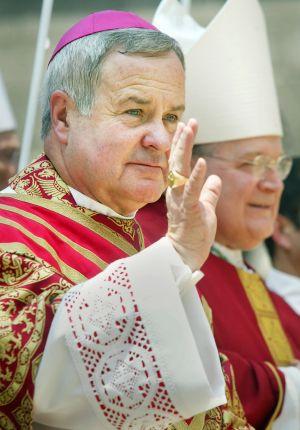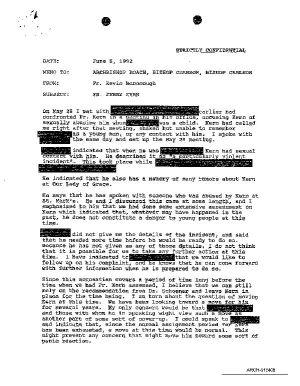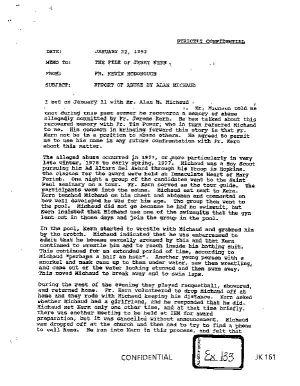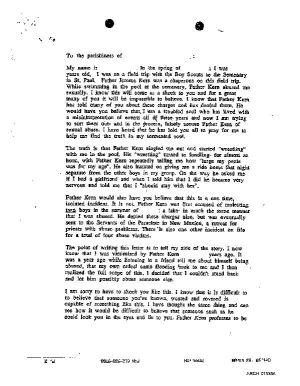Archbishop Robert J. Carlson has reigned over Roman Catholics in St. Louis for the last five years.
But it is a historic lawsuit filed hundreds of miles away in his former home of Minneapolis that now stands as the archbishop’s most significant challenge — one that may determine both his legacy and his future.
The case will attempt to show that for years church leaders such as Carlson mishandled sexual abuse claims in the Archdiocese of St. Paul and Minneapolis and allowed known abusers back into ministry to victimize others.
Already, the Minnesota case led to the release this month of a legal deposition of Carlson that triggered outcry over his response concerning laws about child sex abuse.
But that deposition is only the first in a long series of documents that will be released in the coming months under a judge’s order. The combined release of church records and court filings will for the first time give the public an inside look at Carlson’s tenure in Minneapolis.
The lawsuit could lead to the largest release of documents of its kind, surpassing similar disclosures in Los Angeles, Boston and elsewhere.
Plaintiff lawyers are in the midst of sifting through close to 50 files on priests who the Archdiocese of St. Paul and Minneapolis acknowledge have been credibly accused of sexual abuse. As the Sept. 22 trial date for the lawsuit draws near, as many as 117 files on priests accused of sexual abuse could be made public.
Large portions of the files deal with cases that arose when Carlson was serving as chancellor, vicar general and auxiliary bishop in Minneapolis from 1977-94, when he served as a primary investigator into clergy misconduct. Some of the documents also will shed light on clergy active in the Diocese of Winona, Minn.
The lawsuit involves a plaintiff identified only as “Doe 1,” who alleges the Rev. Thomas Adamson abused him in the 1970s at St. Thomas Aquinas Catholic Church in St. Paul Park, Minn.
The deposition already released shows Carlson claiming he was uncertain whether during his time as auxiliary archbishop in the Archdiocese of St. Paul and Minneapolis he knew that a priest engaging in sex with a child constituted a crime.
Carlson’s statements angered many, prompting hundreds of comments on social media and news websites. The Archdiocese of St. Louis argued that Carlson’s statements were taken out of context and that he was “simply referring to the fact that he did not know the year that clergy became mandatory reporters of suspected child abuse.”
A few days later, the archbishop issued a personal apology — characterizing sexual abuse of children as “deplorable.”
“Actions speak louder than words, and my record on this issue speaks for itself,” Carlson wrote in a letter to parishioners.
Large portions of that record will come to light as the trial date approaches.
‘TRUTH WILL PREVAIL’
The Minneapolis case stands apart from other priest abuse cases filed nationwide, both in its strategy and the scope of documents it could yield.
Attorneys argue the Archdiocese of St. Paul and Minneapolis and Diocese of Winona created a public nuisance by failing to warn of the danger some priests posed to the public, putting children at risk for sexual abuse.
The suit seeks damages. But the remedy for the public nuisance, the lawyers contend, is not any specific dollar amount, but the production of documents that will allow parishioners to be fully aware of the history of the priests, some of whom continue to live in their community.
The case has already compelled the Second Judicial District Court in Ramsey County, Minn., to agree to the releasing of church files relating not only to Adamson — the pastor at the center of the lawsuit — but to all known pedophile priests pertaining to the dioceses.
The first of the files, one pertaining to the Rev. Jerome C. Kern, was released last week.
According to documents, allegations against Kern first surfaced in 1987, when Carlson was auxiliary bishop.
At the time, church officials learned Kern had gone swimming with a group of children at Lake Nokomis in Minneapolis.
On the outing, Kern is alleged to have either touched two boys through their clothes or to have reached underneath the cutoff jeans the boys were wearing, grabbing their genitals. After the alleged incident, in what would be one of several evaluations, Kern was sent to Servants of the Paraclete in Jemez Springs, N.M., for treatment.
Although Carlson and the psychiatrist at Servants of the Paraclete both noted that they did not believe Kern was being completely honest about what had happened, the priest was returned to ministry.
Only a few months prior, in February 1987, Carlson had acknowledged that the Archdiocese of St. Paul and Minneapolis knew that “there really is no cure for someone with the disease of pedophilia.”
Speaking of pastors guilty of sexual abuse, Carlson told the St. Paul Pioneer Press and Dispatch, it was the archdiocese’s “current policy that a minister would never return to parish, because how can you separate working with adults and working with children, since families make up that parish community?”
In the coming years, there would be other allegations against Kern. A 1990 memo, for example, referred to an incident when Kern is said to have pulled down a boy’s pants.
By 1992, another alleged occurrence of sexual abuse by Kern — this one violent — is discussed among church leaders, including Carlson. The memo talks about the possibility of moving Kern, though the letter notes a fear that such a transfer would be regarded as a cover-up.
A memo from the following year tells of yet another alleged incident in which Kern is said to have groped a boy while wrestling in water. The boy, Al Michaud, later brought his concern forward so that “Kern not be in a position to abuse others.”
These memos contain the type of information that critics say should have prompted Carlson to go to authorities.
Yet Carlson has admitted that even after Minnesota law considered him a mandatory reporter starting in 1988, he never personally reported any incidents of sexual abuse to the police. He says he encouraged parents to do so at least once.
In an effort to set the record straight, Michaud would eventually write his own letter to parishioners at Immaculate Heart of Mary Church in Minnetonka, Minn., where Kern was co-pastor.
“Father Kern professes to be a man of the Word — a representative of God. But he stands before you every Sunday in mockery of the celebration of Mass,” he wrote.
“It’s time that the truth be known about Father Kern. And Father Kern, whether it’s now or standing before God in judgment, the truth will prevail.”
JUDGING HIS LEGACY
Although the Minnesota case pertains to abuse alleged to have occurred decades ago, many of the documents released under the court order are recent enough to involve church officials who are still active today.
Among them is Carlson, who turns 70 on Monday and could still lead the St. Louis archdiocese for years to come.
Archbishops aren’t required to file papers for retirement until they turn 75, though they can petition for that option earlier. Carlson has not announced his plans, though he has struggled with health issues.
Carlson’s supporters say that even as the Minneapolis case moves forward, the archbishop’s legacy against sexual abuse is strong.
The Rev. Eugene Tiffany, who met Carlson when they both attended St. Paul Seminary at the University of St. Thomas, said he did not “have any doubt that he (Carlson) is absolutely repulsed by sexual abuse by priests.”
“He’s not soft on offenders,” Tiffany said. “He’s a man of great integrity.”
And there are indications that since his time in Minnesota, Carlson has learned to be more proactive about allegations of sexual abuse.
Sister Mary Carole Curran, a psychologist who worked with Carlson while he was bishop in Sioux Falls, S.D., from 1995 to 2004, said together they systematically informed authorities of sexual abuse allegations.
“He was just wonderful to work with and very careful with people,” Curran said. “Victims felt cared for.”
Here in St. Louis, the archdiocese is also the subject of a major civil case, due for trial July 7, that has focused attention on decades-old cases in which priests who had been accused of abuse were reassigned.
Today, the St. Louis archdiocese has mandated all priests undergo background checks. When someone comes forward with an allegation of sexual abuse, state authorities are notified and priests are removed until an investigation is completed.
Critics point out that these reforms would not have taken place without the Charter for the Protection of Children and Young People established by the U.S. Conference of Catholic Bishops in the aftermath of the sexual abuse crisis.
And some feel the archbishop could do even more to prevent sexual abuse in the archdiocese and assist those who have been victimized.
Jennifer Reyes Lay, executive director of the Catholic Action Network, a group committed to social justice issues, says Carlson should work with members of the Survivors Network of those Abused by Priests.
Others say the public outcry this month over Carlson’s answers in the court deposition show how the Minneapolis case could erode confidence in the archbishop and his handling of sexual abuse.
“I don’t think this is the sort of thing that is necessarily going to blow over very easily,” said one archdiocesan priest who asked that his name not be used for fear it could affect his assignment.
“If he were to retire, there would be a lot of people satisfied, I think.”
Marie Andrews, a parishioner at St. Pius V Catholic Church, says Carlson needs to move beyond the letter he issued to parishioners this month. “I think it’s extremely damaging,” Andrews said. “I did not find that letter helpful at all.
“I don’t live my life based on what the hierarchy says. I look at the people in the pews.”
Still, Andrews says Carlson “should offer a profound apology and start a program of healing.”
“Complete transparency is the only way for the church to go forward.”
Andrews’ own pastor, the Rev. John Rogers Vien, addressed the congregation after he heard about the controversy about the deposition while on vacation in London.
“For some of you, this has reopened old wounds. Others are angry at a church and hierarchy that just don’t seem to ‘get it,’” Vien wrote. “Friends, this is a call to re-examine and to recommit ourselves to the difficult work of bringing about the reign of God.
“Ultimately, I want you to place your faith and trust not in Pope Francis, or Archbishop Carlson, or me, or anyone in this world, but only in Jesus Christ.”




